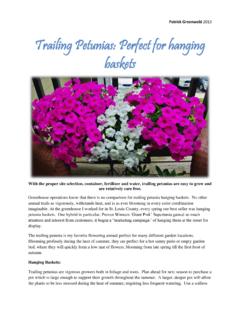Transcription of EFFECT OF ETHYLENE SENSITIVITY ON …
1 EFFECT OF ETHYLENE SENSITIVITY ON development AND germination OF petunia x hybrida SEEDS By JENNIFER LYNN ROLL DAVIS A DISSERTATION PRESENTED TO THE GRADUATE SCHOOL OF THE UNIVERSITY OF FLORIDA IN PARTIAL FULFILLMENT OF THE REQUIREMENTS FOR THE DEGREE OF DOCTOR OF PHILOSOPHY UNIVERSITY OF FLORIDA 2005 Copyright 2005 by Jennifer L. Davis This document is dedicated to my mom, Lynn Roll. ACKNOWLEDGMENTS I would like to acknowledge the support and dedication of my family throughout my graduate research. I would like to thank my husband, Keith Davis, for listening to me throughout my trials and tribulations that were a result of the last four years. I would like to also thank my parents for their continual support and dedication for anything that I do in my life.
2 I would like to thank my sister, Lisa, for being a constant companion throughout our lifetimes. I would like to acknowledge and thank my advisor, Dr. David Clark, who has directed and guided me for the past seven years. Additionally, I would like to thank my committee members, Dr. Harry Klee, Dr. Don McCarty and Dr. Rick Schoellhorn, for advice and direction regarding my research. I would like to thank my lab members that have continually given me advice and kept me sane: Dr. Kenichi Shibuya, Dr. Beverly Underwood, Dr. Kris Barry, Holly Loucas, Rick Dexter, Penny Nguyen and Jason Jandrew. I also would not have been as successful in my research without the advice of Dr. Denise Tieman and Dr. Joe Ciardi, who answered an endless number of questions.
3 Iv TABLE OF CONTENTS page LIST OF LIST OF 1 2 LITERATURE ETHYLENE Biosynthesis, Action and Seed Maternal Plant Role in Seed ETHYLENE in Fruit and Seed development and Subsequent ETHYLENE , ABA, and Sugar in Seed development and Condensed 3 EFFECT OF REDUCED SENSITIVITY TO ETHYLENE ON SEED development , DORMANCY AND Research Materials and Culture and Growth of petunia x hybrida Seed Weight, Seed Size, and Seed Number of petunia x hybrida Developing Sucrose Analysis of Developing CO2 Analysis of Developing Seed development Marker germination ABA germination SENSITIVITY Seed Characterization by Weight, Size, and Seed v Developmental Delay of Seeds Reduced in ETHYLENE The EFFECT of ETHYLENE SENSITIVITY on Seed ABA SENSITIVITY and 4 MICROARRAY ANALYSIS AND CONDENSED TANNIN CONTENT OF petunia SEEDS AFFECTED IN ETHYLENE Research Material and Culture and Growth of petunia x hybrida petunia x hybrida cDNA cDNA Microarray Microarray RT-PCR Confirmation of Microarray RT-PCR of Condensed Tannin Synthesis Vanillin Staining of Microarray Condensed Tannin Analysis of Seeds Carrying The etr1-1 Microarray Condensed Tannin APPENDIX ABI3 ANALYSIS AND MICROARRAY LIST OF BIOGRAPHICAL vi LIST OF TABLES Table page 4-1 Highest ranked differentially expressed cDNAs of a microarray experiment of whole
4 Fruit tissue of ETR (44568) compared to MD at 25 days after 4-2 Highest ranked differentially expressed spots of microarray experiment of maternal fruit tissue of ETR (44568) compared to MD at 25 days after 4-3 RT-PCR confirmation of microarray differentially regulated A-1 cDNA library clones included on microarray chip vii LIST OF FIGURES Figure page 2-1 Proanthocyanin Synthesis 3-1 A picture series of fruit and seed development of all 3-2 Seed size of all genotypes of seeds through 3-3 Average weight of individual seeds of MD, MxE, ETR (44568) and 3-4 CO2 Accumulation throughout 3 hours of developing seeds of MD, ETR (44568), MxE and 3-5 Average number of seeds per fruit of MD, MxE, ETR (44568) and 3-6 Sucrose content of seeds of all 3-7 RT-PCR analysis of seed developmental 3-8 germination of seeds of all genotypes after various storage 3-9 ABA SENSITIVITY of germinating 1 month old seeds of MD, ETR (44568)
5 , MxE and 4-1 Extended RT-PCR expression analysis of microarray differentially regulated 4-2 Highlighted proanthocyanidin synthesis genes observed through RT-PCR expression analysis in all 4-3 Seed pictures of 44568 and 4-4 RT-PCR mRNA expression analysis of genes involved in the proanthocyanidin synthesis 4-5 Freshly harvested and 1 month old seeds of all genotypes stained with 1% A-1 RT-PCR analysis of A-2 ABI3 Southern viii A-3 Complete list of differentially regulated clones in 44568 and MD whole fruit microarray experiment at 25 A-4 Complete list of differentially regulated clones in 44568 and MD maternal tissue microarray experiment at 25 A-5 Complete list of differentially regulated clones in ein2 and MD whole fruit tissue microarray experiment at 25 A-6 Complete list of differentially regulated clones in ein2 and MD whole fruit tissue microarray experiment at 30 ix Abstract of Dissertation Presented to the Graduate School of the University of Florida in Partial Fulfillment of the Requirements for the Degree of Doctor of Philosophy EFFECT OF ETHYLENE SENSITIVITY ON development AND germination OF petunia x hybrida SEEDS By Jennifer L.
6 Davis December 2005 Chair: David G. Clark Major Department: Plant Molecular and Cellular Biology Past research has proven that several hormones play a role in different stages of development , dormancy, and the germination of seeds. ETHYLENE , a gaseous plant hormone, is involved throughout many plant processes including the development and germination of seeds, though the action of ETHYLENE is not completely understood with respect to seeds. The goal of this research was to take a more detailed look at ETHYLENE s role in petunia x hybrida seed development and germination . It was observed in transgenic petunias (44568 CaMV35S::etr1-1) reduced in ETHYLENE SENSITIVITY that ETHYLENE primarily acts by stimulating the developmental time-course and thereby increasing germination rates.
7 The full time-course of seed development was delayed in homozygous 44568 seeds by approximately five days compared to wild-type Mitchell Diploid (MD) seeds. Also, when the two lines were reciprocally crossed, only seeds produced on the 44568 maternal plants displayed the phenotype of delayed seed development . When germination was assayed, both x hemizygous and homozygous seeds carrying the etr1-1 transgene had reduced germination , but both were able to recover to MD germination levels after six months of cold storage. All seeds carrying the etr1-1 transgene were also more sensitive than wild-type to exogenously applied ABA during an additional germination assay. Differences in gene expression between 44568 and MD were observed through microarray analysis.
8 The results of the microarray experiments and the observation of a color difference of freshly harvested seeds altered in ETHYLENE perception led to further analysis of proanthocyanidins, or condensed tannins. Expression analysis of genes involved in condensed tannin synthesis did not exhibit any major differences between the genotypes carrying the etr1-1 transgene versus MD. Overall, the primary findings of this research were that the ETHYLENE SENSITIVITY of the maternal parent had a significant role in the developmental timing of seeds. Conversely, the overall decreased SENSITIVITY of the zygotic tissue to ETHYLENE determined the stronger dormancy induction and heightened ABA germination SENSITIVITY observed in all seeds carrying the etr1-1 transgene.
9 Xi CHAPTER 1 INTRODUCTION Angiosperm seed development is mediated by an assortment of genetic programs involving hormones, fatty acids, storage proteins, carbohydrates and many other components of plant growth and metabolism. The seed is composed of several tissues including the embryo, endosperm, and the testa or seed coat. The embryo contains the tissues that include the root and shoot meristems which develops into a seedling. The endosperm is comprised of an epidermal layer, an aleurone, and nourishing tissue surrounding the embryo. The seed coat provides a protective cover over the other tissues (Harada, 1997). A seed undergoes a complex course of development after fertilization until the point where it is considered a mature seed capable of germination .
10 The development of the embryo after fertilization occurs in three general stages: differentiation of tissues, cell enlargement and maturation (Buchanan et al., 2000; Chaudhury and Berger, 2001). Some seeds enter dormancy after maturation, while other seeds immediately become ready for mobilization of stored reserves in preparation for germination to begin. There are two types of dormancy: primary and secondary. Dormancy is defined as the inability of mature seeds to germinate under favorable conditions (Bewley, 1997). Primary dormancy occurs in the freshly-harvested seed; it develops during seed development and maturation on the mother plant. The maintenance of primary dormancy is determined by environmental and genetic factors (Bewley, 1997; Gubler et al.)



















